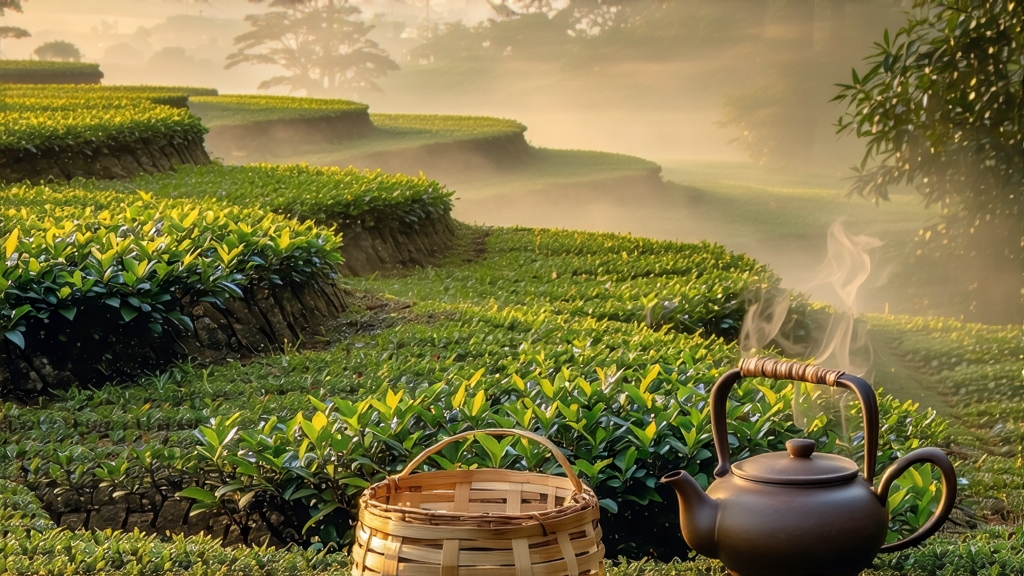
High among the perennially cloud-capped Meng Ding Mountains of Ya’an, Sichuan, a tea once reserved for emperors still unfurls its down-covered buds each early April. Meng Ding Huang Ya—literally “Yellow Bud from Meng Peak”—is the least-known yet most aristocratic member of China’s yellow-tea family. While green tea dominates export menus and puerh fills investment vaults, this gentle yellow sibling survives in tiny lots, made only when spring humidity, temperature, and skilled hands align for a fleeting ten-day window. To understand it is to glimpse a vanished world of Tang-dynasty court tribute, secret “men-huang” fermentation chambers, and tea monks who believed the elixir could “illuminate the mind.”
History: from palace secret to near extinction
Tea texts from 808 CE record that Meng Ding teas were carried by fast horse to Chang’an, arriving while the leaves were still warm. The Song emperor Huizong (r. 1100-1125), himself a gifted tea connoisseur, elevated Meng Ding to first-rank tribute, reserving the smallest, most uniform buds for the throne. When Ming Hongwu later banned compressed tribute cakes, the mountain shifted to loose-leaf, inadvertently creating the conditions for yellowing. By the late Qing, the technique—wrapping lightly fixed leaves in thick paper or cloth to sweat for 30–50 hours—was passed among three hereditary families. Warlords, bandits, and the 1960s communal farming almost erased it; only a single 78-year-old master, He Guo-cheng, kept the memory alive by producing one kilogram a year for his own birthday. In 2005 a group of young agronomists recorded his motions on video, and today perhaps 200 mu (13 hectares) are again cultivated under organic certification, but annual yield hovers below 300 kg, making each gram a time capsule.
Micro-terroir: where clouds polish the buds
Meng Ding is a granite dome lifted 1,450 m above the Chengdu plain, trapping the Indian monsoon against Tibetan cold air. The result is 280 foggy days a year, diffuse sunlight, and nightly dew that condenses into horizontal “cloud belts.” The tea gardens sit just above these belts at 1,000–1,200 m on acidic yellow-brown soil rich in selenium. Cultivar is a local shrub-type Camellia sinensis var. sinensis locally called “xiao-ye-zhong” (small-leaf race) whose cells contain up to 8 % theanine, twice that of lowland bushes. Buds emerge slowly, accumulating amino acids while keeping catechins low, yielding the hallmark sweet-broth texture without the grassy bite common to early green teas.
Plucking: one bud, one unfolding leaf, before the temple bell
Work begins at 05:30 when mountain temperature is 8 °C, locking in fragrance. Pickers—usually women aged 45–60 whose fingertips are calloused yet supple—snap the stem with the nail of the index finger to avoid bruising. Standard is “1.5 leaves”: the unopened bud plus the first leaf just 1–1.5 cm long, weighing no more than 0.2 g fresh. A full day’s basket holds barely 500 g, enough for 100 g finished tea. Leaves arrive at the cottage factory by 09:00, still cool and fragrant like rain-soaked bamboo.
Craft: the dance of fixing, wrapping, and bamboo-roasting
- Pan-firing (sha-qing): 180 °C for 3 min 20 s
A wok shaped like an inverted moon is fueled by local cypress; its resin perfumes the leaf. The master’s palm tests the surface—too hot and the down on the bud will scorch, too cool and enzymatic activity lingers. - Initial rolling (cuo-tiao): 5 min
Light pressure bruises the edges just enough to rupture 30 % of cells, starting oxidation without visible reddening. - First yellowing (men-huang): 32 °C, 85 % RH, 14 h
The leaves are wrapped in three layers: breathable rice paper, then hemp cloth, finally a bamboo husk. Stacks are slid into a pine wardrobe whose interior is steamed daily to maintain humidity. During this sweat, chlorophyll degrades to pheophyt